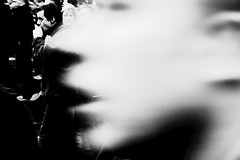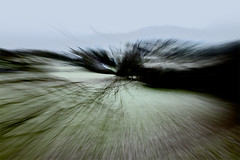Introducing a new series: Songlines.
By some remarkable coincidences things just seemed to fall into place on Friday. Reading, conversations, seeing and photography combining to create new thinking and a new series that I suspect I will be pursuing for a long period of time.
The first element was seeing. While wandering through my local beech woods, and looking (vaguely) for something that will progress onwards from my Mametz Wood series, I started to notice something new to me. There were strange patterns, shapes and forms in those trees that could if we recognise them as such be called simply ’art’. What struck me was that it needed a person to not only see that art, but to recognise it as such. In short, there's art out there and it's growing on trees!
The second element was reading ColinPantall's blog about Robert Macfarlane’s new book ’Landmarks' and how important the naming of things can be to the recognition of their existence. He used the example of the ’Missing Buildings’ project by Thom and Beth Atkinson. Those missing building are all around us, but it's only in their naming that they become significant. To quote Colin “Experience leads to language and language leads to seeing. And seeing leads to photography.” And I still needed a name for the tree art I'd discovered.
The third and final element was a Twitter conversation with John MacPherson about my Songs of Travel series. He asked if the title came from Bruce Chatwin’s book Songlines. I responded, without realising the significance at the time, that it, in fact, came from a Robert Louis Stevenson poem. And thought nothing more of it, for a while...
It was a couple of hours later that I realised that there was a name for this tree art, one that was already in existence and that the Songlines that John had spoken of would be perfect. Naming equals significance.
Songlines are a creation myth held by the indigenous peoples of Australia that, to quote Bruce Chatwin “...tell of the legendary totemic being who wandered over the continent in the Dreamtime, singing out the name of everything that crossed their path - birds, animals, plants, rocks, waterholes - and so singing the world into existence."
“In some cases, the paths of the creator-beings are said to be evident from their marks, or petrosomatoglyphs, on the land, such as large depressions in the land which are said to be their footprints.” Wikipedia.
I can't claim to share such animist beliefs, but I do feel a close affinity with trees and forests. Indeed, I wrote a poem a few years ago with the simple line “Tall trees temple” attempting to express that feeling of otherworldliness we sometimes get from being in the forest, the analogy being with a similar feeling we might experience in a church. The belief I can happily share is the need to ’sing the world into existence’ or that naming things gives them a power and maybe an existence they could not possess unnamed.
The images are presented as negatives. As any film photographer will know the negative image can have a beauty and otherworldliness all of their own. And to me that encapsulates what I'm seeing, the otherness and the requirement for us to see in new ways. To recognise art when it's before us. What a wonderful world!










